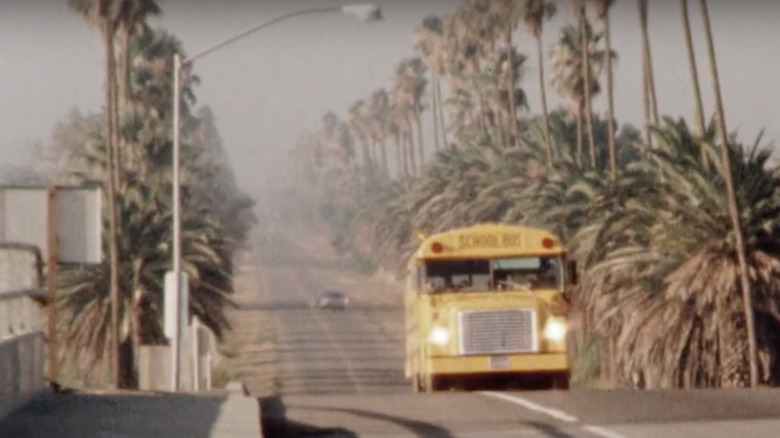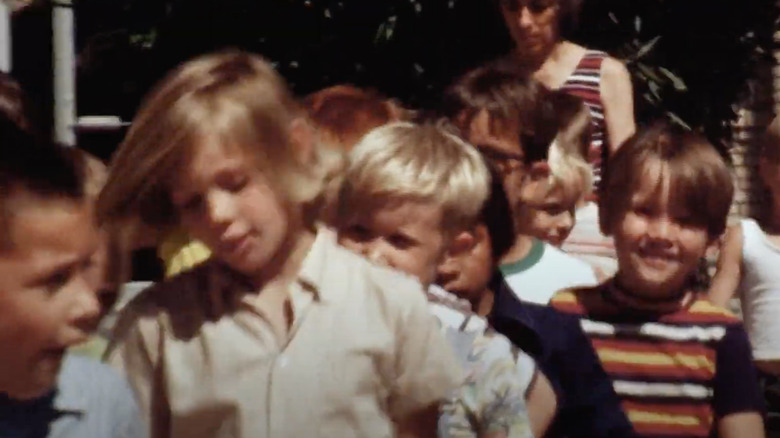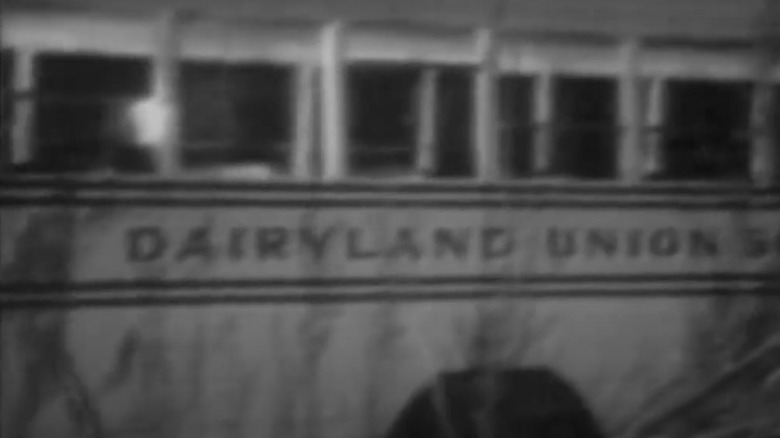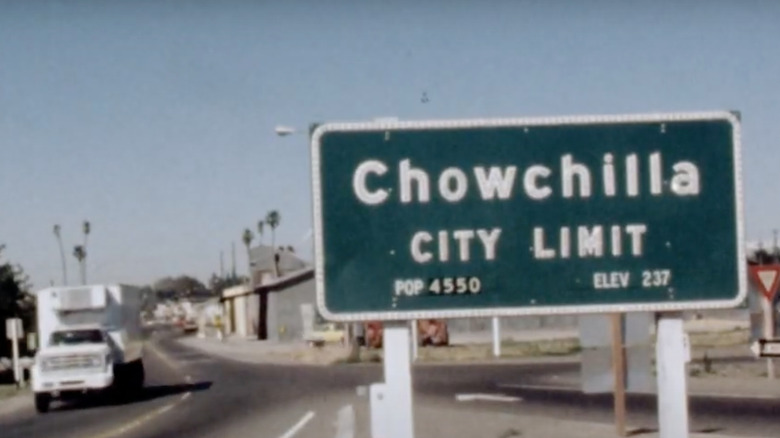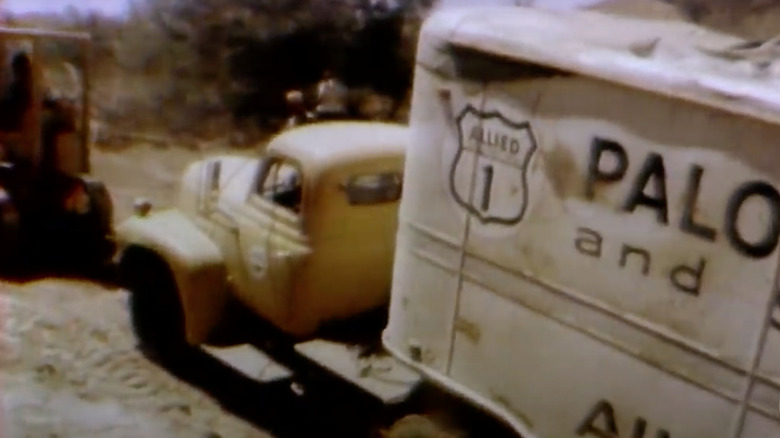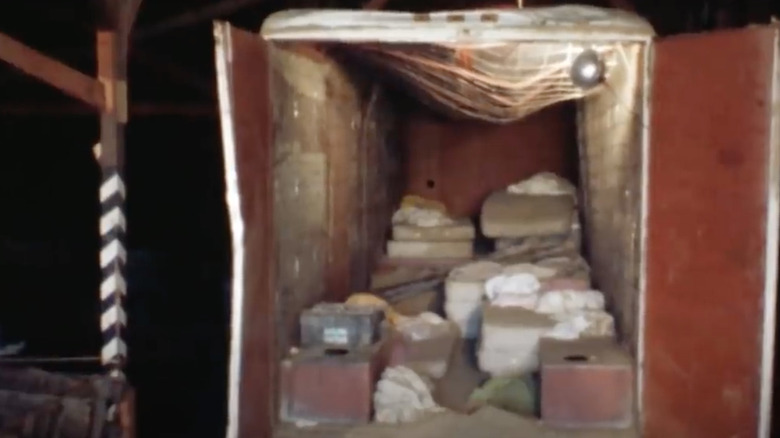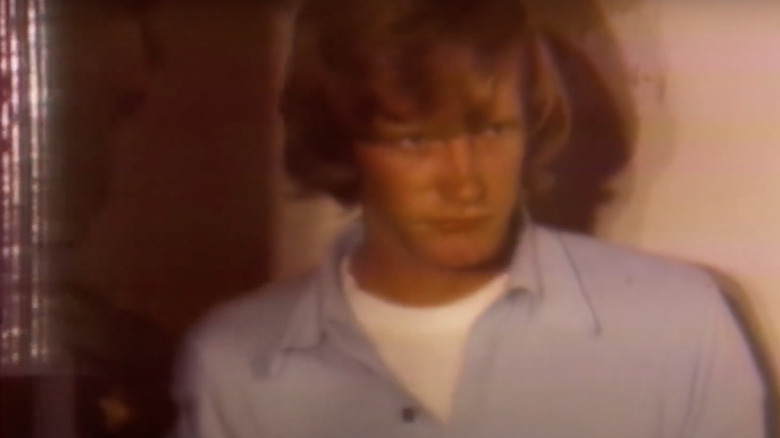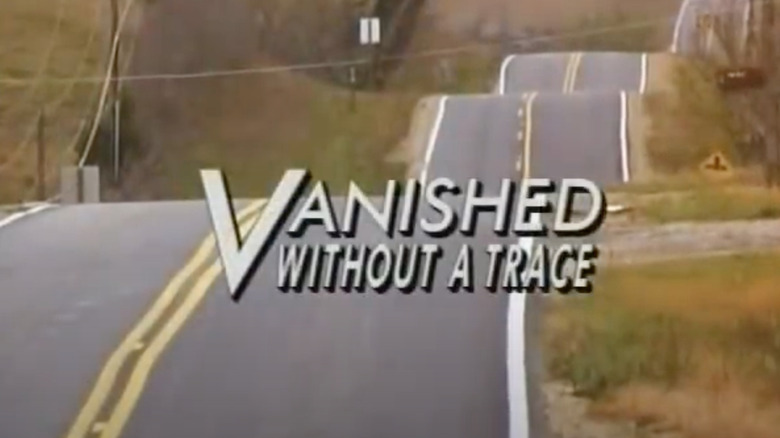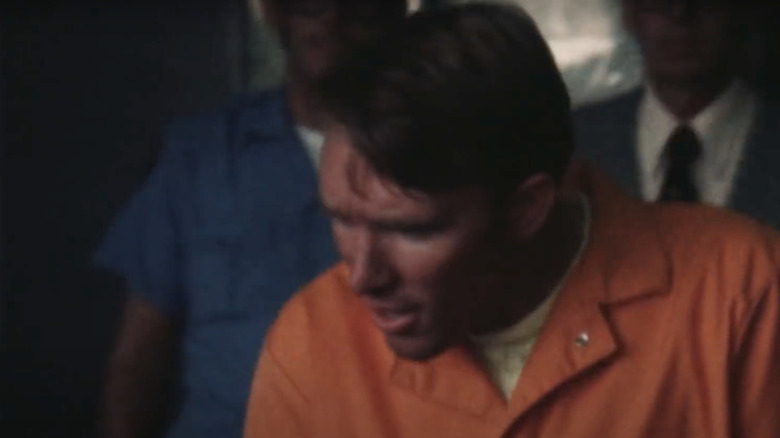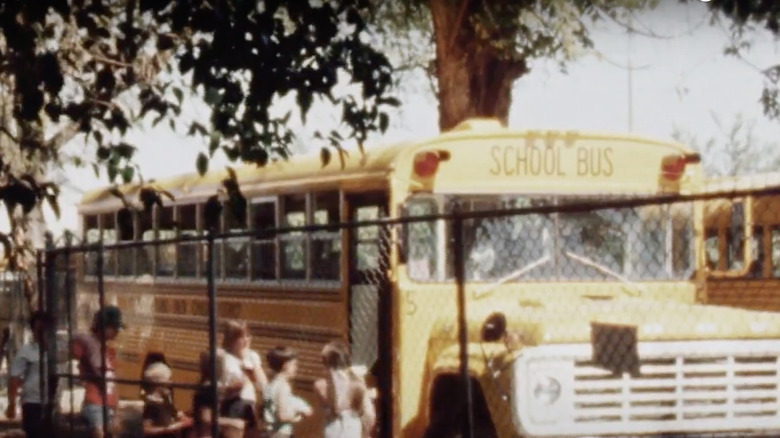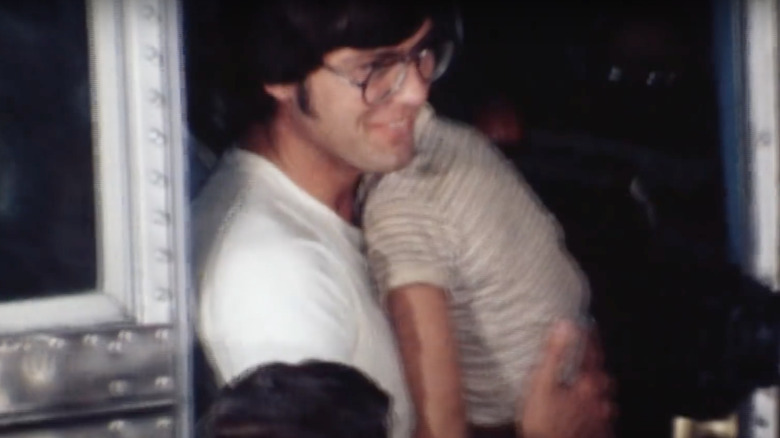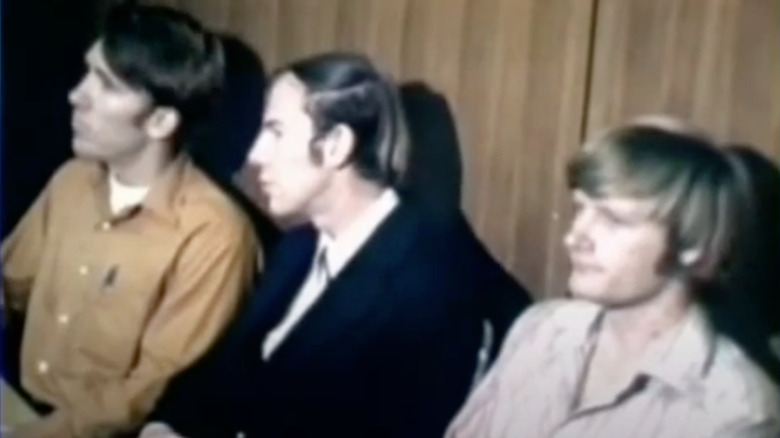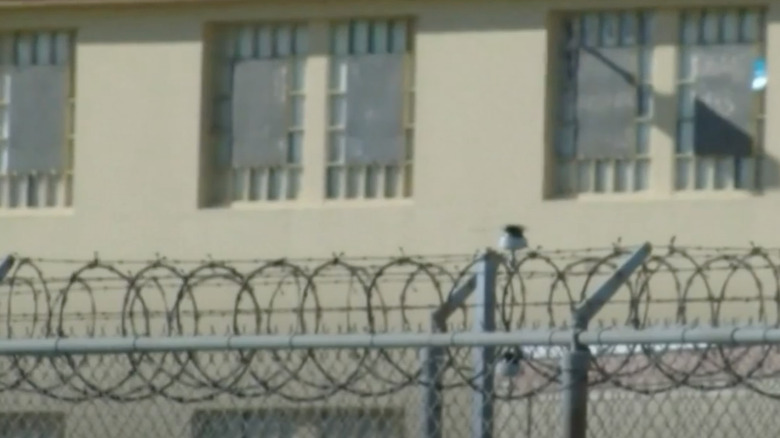Chilling Details About The School Bus Of Kids Buried Alive In 1976
We may receive a commission on purchases made from links.
The following article includes traumatic events.
It was another scorching summer day in Chowchilla, California, on July 15, 1976, when summer school students from Dairyland Elementary climbed back on the bus after cooling off at the community pool. Bus driver Ed Ray was driving them home when he noticed a van in the way at the side of the road and, according to Vox, tried to maneuver the bus around it. It was not long after when the nightmare began.
The Chowchilla kidnapping would come to be known as one of the most heinous crimes ever committed against children. Ray and the 26 kids on his bus were forced onto windowless vans at gunpoint, driven over a hundred miles into the unknown, and then ordered to climb down into an underground bunker where they would endure 16 hours of torture. This was what really happened on that sweltering day — and why some of the survivors never really escaped the horror.
Nobody knew what was going on
The entire city of Chowchilla was confounded — and frightened. As one worried mother told FOX 11 Los Angeles at the time, "It was like somebody came down from Mars and just took them up off the planet." FOX 11 recounts that summer school was almost over, the children had gone swimming at the local pool, and were taking the bus back when they vanished. Some who jumped on the bus had not even bothered to change out of their bathing suits.
What happened became primetime news, and according to the podcast "Nightmare in Chowchilla," the mysterious abduction made international headlines. Rumors of a parent possibly being involved were being whispered. Sheriff Ed Bates, now retired, told the podcast he thought a parent might have stopped the bus to pick up their child early. Police eventually assumed this had to be a mass kidnapping despite the lack of evidence. Some parents grabbed their CB radios and joined the search. The FBI soon got involved in scouring not just Chowchilla, but the entire San Joaquin Valley, in an effort to find any trace of the victims.
After the empty bus was found half-buried by weeds in a riverbed that had dried up in the summer heat, according to KIRO 7, there was still no idea who or what might have snatched away so many children.
Captors in pantyhose masks held them at gunpoint
In an interview with CBS News, survivor Jennifer Brown Hyde recalls three men masked in pantyhose holding her and everyone else who had been on that bus at gunpoint. "She would later say that it felt like she and the others were 'going to the slaughterhouse,'" Jodie Huffington, only 10 at the time, told NBC News, adding that her captors were threatening them with sawed-off shotguns. Another survivor, Larry Park, told 48 Hours (via KIRO 7) about the effect something so unlikely as pantyhose had in distorting the abductors' face. "Where their eyes were, it was like, it almost looked hollow", he said. "It was like looking at death."
That was just the beginning of what would turn out to be a harrowing journey. According to CBS News, the children were forced out of the bus after it was driven into the riverbed. They were loaded onto vans by the eerily masked men, but not before giving their captors what they wanted. As Larry Park told KCRA-TV (via the Center for Sacramento History), '[one of them] asked me my name and age [and] then he wanted my pants and my boots," something they did with all the children, one by one.
As if that isn't enough, the kids couldn't just walk to the vans that were waiting for them, because as WCBI remembers, they had to jump. The perpetrators didn't want any footprints left behind.
They were driven somewhere unknown in windowless vans for 12 hours
The torture for the children and Ed Ray extended beyond being buried alive — that came later. Once on the vans, which were boarded up on the inside (chilling photos paint a harrowing picture), they then had to endure a suffocating 12-hour ride, according to CBS News. The windows of the vans had been painted over so no one could tell where they were headed. Conditions inside the vans only kept growing worse as they drove on, if you ask FOX 11. There were no opportunities for bathroom breaks or even a chance to breathe fresh air.
As Jennifer Brown Hyde told WCBI, "Didn't know where we were going. Didn't know what they were going to do with us ... we drove for what seemed like hours upon hours upon hours." She remembered being one of the older children trying to comfort the younger ones who had started crying. In the same interview, Larry Park recalled that he kept falling asleep to dreams of camping with his family and then abruptly waking back up into the hell he had fallen into. Reality itself had become a nightmare.
There as no relief when the vans finally stopped. In the WCBI interview, Park and Hyde said that Ed Ray was ordered to disembark the van, and everything went silent. Then the horrors started again. Hyde said that the captors "grab[bed] the first kid that was inside the door", and since they kept repeating that over and over again, she thought she would be safe if she cowered in the shadows at the back of the van. She wasn't.
They were literally buried alive in a trailer underground
After a grueling drive, the 26 kids and Ed Ray ended up in Livermore, California, where a moving van and been purposely buried in a rock quarry, according to the official website of the City of Chowchilla. This was where they would spend another 16 hours trapped underground.
The kids were told to take flashlight climb down a ladder into this makeshift prison, as Vox said. There were crude toilets carved out and mattresses to sit on, as shown in some of the photos compiled by CBS News, and ventilation pipes that made it possible to just barely breathe from 12 feet underground. There was water and some food — bread, cereal, and peanut butter — but conditions took a turn for the worse pretty fast. KCRA-TV (via the Center for Sacramento History) observed that there was hardly enough food or water to last until the captors got whatever they wanted.
The heat was unbearable. In an interview with CNN, survivor Linda Labendeira remembered the bunker being like a "coffin," and there was constant, inconsolable crying. Larry Park was 6 years old when he found himself surrounded by a darkness he thought might engulf him forever (via WCBI). In the "Nightmare in Chowchilla" podcast, he said, "The screaming, to this day, is buried in the audio files of my memory."
It was almost impossible to escape, and then the roof caved in
The perpetrators really made sure no one would be going anywhere soon. They had snatched away the ladder after the last of the victims made their way down, and the bunker was weighed down with plywood, steel, dirt, and heavy truck batteries to keep them from breaking out, according to KCRA-TV (via the Center for Sacramento History). Truck batteries can weigh up to 180 pounds each, for reference. With all that junk piled on the roof, what would happen next was just about inevitable.
On the "Nightmare in Chowchilla" podcast, survivor Mike Marshall remembers that, in the midst of anguished cries and prayers, something changed. An impatient victim was kicking at one of the posts holding up the ceiling of the buried trailer when there was a sudden crash. The roof had started caving in at one end, which also crushed one of the air vents. Screaming intensified. Marshall, who was then 14 and had almost accepted imminent death (even Ed Ray had nearly given up), decided this was their chance. They looked up at the ceiling and went for it.
Marshall and Ray stacked mattresses to reach the ceiling, climbed them and tried to muscle and claw their way out any way they could. To young Larry Park, as he said on the podcast, "Mike was Hercules. Mike was Sampson. Mike was the man that slayed the beast."
Why did the perpetrators do it? Money and horror movies
As KTVU TV news producer John Fowler told the "Nightmare in Chowchilla" podcast, he was shocked to find out that the perpetrators, Frederick Woods and brothers James and Richard Schoenfeld, were all twenty-somethings born into wealth — but broke themselves. The fastest money grab they could think of was a ransom. According to Vox, they targeted children because missing kids tend to trigger the most desperation.
The trio also knew that California had gotten out of the $5 billion budget surplus ordered by governor Ronald Reagan, as the Monterey Herald remembers. The Herald references a page in a testimony that recounts James Schoenfeld saying, "The idea just started [as a] way to get this money." They didn't think the state would miss the $5 million they later put down in a ransom note (which wouldn't be seen by law enforcement until after they were behind bars).
According to Vox, Wood aspired to be a Hollywood producer and wanted to use some of the money for film projects in the future. The New York Times says the crime was also partly inspired by an infamous scene in "Dirty Harry" where a school bus was hijacked by a serial killer. The difference here was that Clint Eastwood wasn't around to save the day, and the victims would have to save themselves.
An actual horror movie was made about it
Some things can be scarier than fiction. While Frederick Wood never got to make the horror movie he dreamed of, "Vanished Without a Trace" was made about the horrific crime. According to TCM, the 1993 film is known by several titles and stars Karl Malden as Ed Ray, with Tim Ransom, Travis Fine, and Tom Hodges as the perpetrators.
After he and his accomplices found out the 27 victims had somehow broken out of the bunker, Woods hightailed it to Canada and waited for the others to catch up, according to Vox. He started dreaming of movies again. This was when he wrote a letter that would make him famous for a different and much more negative reason. Under a pseudonym, he tells his screenwriter friend that a movie based on the crime would be a box office smash (spoiler alert: "Vanished Without a Trace" wasn't, even though he had no involvement in it). That letter Fred had written would be used against him in court.
The FBI got in touch with Canadian law enforcement, who captured not only Woods, as CBS News recalls, but James Schoenfeld as he made his way across the border. Rick Schoenfeld had turned himself in earlier. Then-sheriff Ed Bates told CBS that he thought Woods was the mastermind behind the crime, and that the brothers "did it just on pure persuasion."
The trauma was so severe that it was brought up in the trial
In the 1970s, mental trauma inflicted by a crime was not taken as seriously as physical trauma, but according to KCRA-TV (via the Center for Sacramento History), the prosecution really tried to prove that it was just as severe as physical harm. There was little to no physical harm that could be proven, and the prosecution was aware that "everything [had] to be on a psychological basis", as one of the prosecuting attorneys told KCRA.
The prosecutors were (unfortunately) ahead of their time. As another attorney speaking for the prosecution told KCRA, "The judges ruled that we can't show psychological damage per se". It didn't hold up as bodily injury. Neither did the extended period of time the victims had to suffer with barely any food, water or air in cramped conditions with unbearable heat, which was something else the prosecution was trying to prove as bodily harm.
The perpetrators would never walk free again if it was found their cinematic heist had done physical damage to any of the victims. As a New York Times article from 1976 says, bodily harm would have had Woods and the Schoenfelds facing life with no possibility of parole.
Young lives were turned upside down by PTSD
While the kids were relieved to be rescued, they would suffer symptoms of PTSD. A 1979 study published in the American Journal of Psychiatry, found the trauma manifested in many ways, including a pessimistic outlook, nightmares, panic attacks, hallucinations, personality changes, and other fears that were directly linked to the kidnapping. Symptoms were found to be similar regardless of how old the children were when they were abducted.
Trauma would persist, and not much improved when they were reevaluated in 1981. A 1983 study, also published in the American Journal of Psychiatry, that followed up with the survivors found that "every child exhibited posttraumatic effects". That study also noted that "brief treatment ... after the kidnapping did not prevent symptoms and signs 4 years later." Psychiatrist Lenore Terr was behind all of these studies. According to a 1982 Washington Post article, she noticed some of the children would play "burying Barbie" and reenact what happened to them in other ways, even several years later.
Terr called the parents when she found out their children were receiving no therapy because they appeared to be physically unharmed, and the Post said some called her "an angel."
If you or someone you know is struggling with mental health, please contact the Crisis Text Line by texting HOME to 741741, call the National Alliance on Mental Illness helpline at 1-800-950-NAMI (6264), or visit the National Institute of Mental Health website.
The survivors still deal with PTSD decades later
Linda Labendeira was in the fourth grade when she was buried alive along with 26 other victims. "So much of my life, people wonder how I ever sleep — if I ever sleep," she told CNN. Since the abduction, Labendeira has tried to keep herself from sleeping too deeply so she can avoid recurring nightmares of choking on the stale, hot air in the dark, filthy underground prison she was trapped in. She was horrified when she found out the convicts became eligible for parole in 1980, when the court decided to give them another chance because they hadn't physically injured anyone. She went to every parole hearing, which was like reliving the monstrosity all over again.
Some survivors turned to drugs and alcohol later in life. Jennifer Brown Hyde lost her brother to a tragic accident not long after the kidnapping, and told 48 Hours she became "an angry individual ... [and] an absolute mess." She also admitted that she "made a lot of bad choices in life after that." It is now difficult for Hyde, who told Fox News she thought she would literally die in the bunker, to hide in her crawlspace whenever a tornado warning comes up.
Mike Marshall, who was a dauntless demon slayer in the eyes of Larry Park, is now 60. FOX 11 reports that he still lives with his mother and has an emotional support animal with him at all times.
One of them faced his captors years later
Larry Park went through such severe trauma that, according to ABC, he suffered from schizophrenia and addiction most of his life. He blamed Frederick Woods and the Schoenfelds for all his problems for decades. After getting sober, he decided to get something else off his chest.
Park wrote the book "The Chowchilla Kidnapping: Why Me?" In it he says, regarding the first parole hearing he ever went to, "I've always been afraid of these demons and whenever I've tried not to be afraid of them, they have visited me in my dreams, making me relive the torture of abduction." However, he went to that hearing regardless of how it haunted him because he felt that he needed the right to protest, but something unexpected ended up happening later on. USA Today reports he actually forgave each of his captors in person and pushed for parole instead of against it. For him, it was cathartic.
Though Park still faces fears of darkness and crowded areas, he told FOX 26 News, "Since I have found the freedom of forgiveness, I know that I am a better person."
If you or anyone you know is struggling with addiction issues, help is available. Visit the Substance Abuse and Mental Health Services Administration website or contact SAMHSA's National Helpline at 1-800-662-HELP (4357).
The convicts all walked free in the end
Though many of the survivors feel that their captors should have all done life without parole, all three were eventually freed from prison. Some of these former kids, like Larry Park, accept this (via USA Today). Others are outraged and wish the three would serve life without parole.
Survivor Jodie Huffington told NBCLA that she remembered being 10 years old and looking down the barrel of one of the sawed-off shotguns that was being pointed right at her face. She said that even the longest sentence, which ended up being 39 years for Woods, was "not long enough," and she saw it as "a definite slap in the face." Linda Labandeira was 9 at the time of the kidnapping and had a similar reaction when the court granted James Schoenfeld parole. As she told KFSN (via CBS6 Albany), she was "nauseous and then very tearful" when she found out.
Richard Schoenfeld, who turned himself in, got parole in 2012, and his brother James joined him in 2015, according to CNN. They now live with and care for their mother. Woods was approved for parole in early 2022. Was the absence of physical injury really enough to justify their release? It is a question only the survivors can answer.
